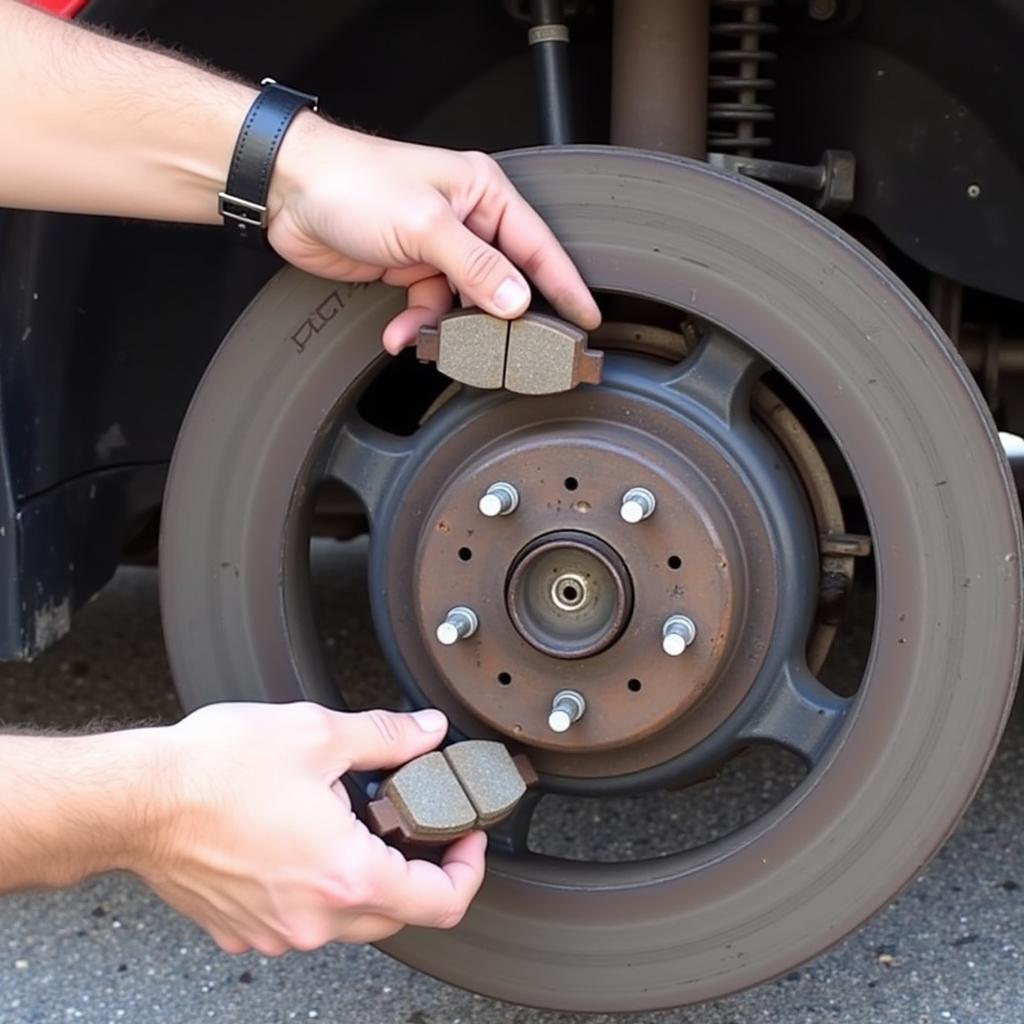The dreaded brake light warning light on your 2002 Pontiac Grand Am. It’s a common issue, and while it can be frustrating, it doesn’t always mean a catastrophic brake failure. This article will guide you through the common causes, diagnostic procedures, and solutions for a 2002 Pontiac Grand Am brake light warning light on, empowering you to troubleshoot the problem effectively.
Understanding the Brake Light Warning Light
The brake warning light is part of your car’s self-monitoring system. When illuminated, it indicates a potential problem within the braking system. This could range from something as simple as low brake fluid to more serious issues like a faulty ABS sensor or a failing master cylinder. Identifying the root cause is crucial for a safe and effective repair.
Common Causes of a 2002 Pontiac Grand Am Brake Light Warning Light
Several issues can trigger the brake light warning light in a 2002 Pontiac Grand Am. These include:
- Low Brake Fluid: This is often the most common culprit. Over time, brake pads wear down, and the brake fluid level naturally drops. If it gets too low, the warning light will come on.
- Faulty Brake Light Switch: The brake light switch is located under the brake pedal and activates the brake lights when the pedal is pressed. A malfunctioning switch can cause the warning light to illuminate.
- Worn Brake Pads: Worn brake pads not only reduce braking effectiveness but can also trigger the warning light, particularly if they are excessively worn.
- ABS Issues: Problems with the Anti-lock Braking System (ABS), such as a faulty sensor or a wiring issue, can trigger the brake warning light.
- Master Cylinder Problems: The master cylinder is a vital component of the braking system. Leaks or internal failures in the master cylinder can cause a loss of brake pressure and trigger the warning light.
Diagnosing the Problem
Diagnosing the brake light warning light requires a systematic approach:
- Check the Brake Fluid Level: Open the hood and locate the brake fluid reservoir. Check the fluid level and top it off if necessary. Use the correct brake fluid type specified in your owner’s manual.
- Inspect the Brake Light Switch: Locate the brake light switch under the brake pedal. Test the switch for proper operation using a multimeter. Replace the switch if faulty.
- Check the Brake Pads: Visually inspect the brake pads through the wheel spokes. If they appear thin or worn, have them measured by a mechanic.
- Scan for ABS Codes: If the issue persists, use an OBD II scanner to check for any stored ABS codes. These codes can pinpoint the specific problem within the ABS system.
 Inspecting Brake Pads on a 2002 Pontiac Grand Am
Inspecting Brake Pads on a 2002 Pontiac Grand Am
Fixing the Issue
Once you’ve diagnosed the problem, take the appropriate action:
- Add Brake Fluid: If the fluid is low, top it off with the correct type. If the fluid level drops quickly, it indicates a leak that needs immediate attention.
- Replace the Brake Light Switch: Replacing the brake light switch is a relatively simple DIY task. Disconnect the electrical connector, remove the switch, and install the new one.
- Replace Brake Pads: Worn brake pads require replacement. This can be done yourself or by a mechanic.
- Address ABS Issues: ABS problems often require specialized diagnostic equipment and expertise. Consult a qualified mechanic for diagnosis and repair.
- Repair or Replace the Master Cylinder: Master cylinder issues, especially leaks, warrant professional attention. A mechanic can determine if the master cylinder needs repair or replacement.
Expert Insight
“Ignoring a brake warning light can have serious consequences,” says automotive expert, Robert Johnson, ASE Certified Master Technician. “Addressing the issue promptly can prevent further damage and ensure your safety on the road.”
Conclusion
A 2002 Pontiac Grand Am brake light warning light on signals a potential problem within the braking system. By following the diagnostic procedures outlined in this article, you can identify the root cause and take the appropriate action. Remember, a properly functioning brake system is essential for your safety. Don’t delay addressing this issue. If you are unsure about any step, consult a qualified mechanic.
FAQs
- Can I drive my 2002 Pontiac Grand Am with the brake light on? While you might be able to drive a short distance, it’s strongly advised against it. A malfunctioning brake system can lead to reduced braking performance and dangerous driving conditions.
- How much does it cost to fix a brake light warning light issue? The cost varies depending on the underlying cause. Adding brake fluid is inexpensive, while replacing major components like the master cylinder can be more costly.
- How often should I check my brake fluid level? Check your brake fluid level at least once a month as part of your regular vehicle maintenance.
- What type of brake fluid should I use in my 2002 Pontiac Grand Am? Consult your owner’s manual for the correct brake fluid type. Using the wrong type can damage the braking system.
- Can I replace my brake pads myself? While it’s possible, replacing brake pads requires some mechanical knowledge and tools. If you are unsure, consult a mechanic.
- What is the ABS system, and why is it important? The Anti-lock Braking System (ABS) prevents wheel lockup during hard braking, allowing you to maintain steering control.
- How can I find a qualified mechanic to work on my 2002 Pontiac Grand Am? Ask for recommendations from friends and family, or search online for reputable mechanics specializing in Pontiac vehicles.

